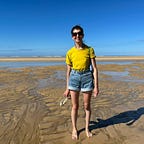Paloma Varga Weisz: Bumped Body
On entering the Henry Moore Institute, I first see a collection of framed portraits. Drawings of faces and assorted body parts are captured in ink and watercolour. Their soft edges point, for me, to the fluidity, the validity, the inherent absurdity, of all bodies. This could be a family album, each individual stopped in time, mid-metamorphosis.
A sculpted body, Bumpman (2002), is located in front of these images. This creature is seated on a wooden stool, its head tilted and gazing skywards, a kind of bobbly Buddha. Coloured-in bumps appear to melt from its body, hinting at an evolving experience, a shedding skin….or maybe these bumps are protective, discouraging close contact. The sculpture is an in-betweener, more of a fellow spectator than an artwork.
In the next room, a cabinet is filled with wood-carved curiosities showcasing Varga Weisz’s significant craft skills; intricate sculptures of heads and little bodies, human and animal (Schrank, 2018). These figurines are combined with objects isolated from nature: a birds nest, eggs and a pine cone. Beside the cabinet is Father, Old (2011), an imposing, lined and shiny ceramic face displayed around head height for the viewer. It is coming at me through the wall, a ghost made solid, intangible matter crystallised.
Haus/House (2018) is a dolls house-style sculpture on table legs. It’s a new thing made from old parts, which carry an essence of their previous functions. Rough wooden panels are held together with bent nails and aging, time-crisped lace curtains hang from the windows. It makes me think of how each of us arrives in the world a so-called ‘new’ being, yet really we are the sum of old experiences, memories and behaviours, handed down to us somatically or later by word of mouth or through bearing witness. Varga Weisz’s father had fled from the Nazis and she describes a subsequent ‘heavy atmosphere’ in her family home in Germany. The stories her father told her of his experience when she was a child took on the magical quality, for her, of a fairy tale. This sense seems to me perfectly represented in the repurposing of materials to build the dolls house; the notion of familial trauma, explained to us as children, is remoulded by us with our tiny perspective. Family histories and fictions are bound up with our lived experience, real and imagined, to create our own, individual, reality.
Outside the Henry Moore Institute, there is another bumpy body, sculpted in bronze. Reflected on the gallery’s exterior wall on a grey and drizzly day, Bumpman on a Tree Trunk (2018) could be a mascot for this strange year on earth; a lonesome, wistful, everyman. I think all of us are bumped from the moment we inhabit our bodies. The bumps add up to each of us as a whole human, not a fixed quantity but a growing, changing being.
The exhibition closed during lockdown and has since been extended to 3rd January 2021, book tickets via the HMI website https://www.henry-moore.org/whats-on/2020/03/13/paloma-varga-weisz-bumped-body
Conversations between Paloma Varga Weisz and the exhibition curator helped to inform this review https://www.henry-moore.org/whats-on/2020/06/23/paloma-varga-weisz-in-conversation-with-laurence-sillars
